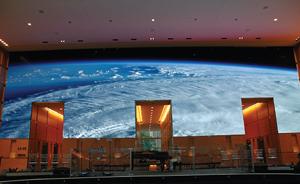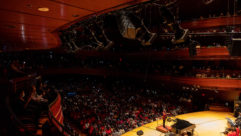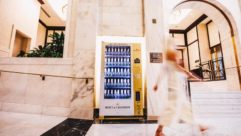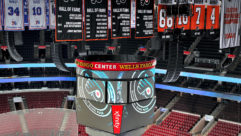

The Philly Experience
Except for the fact that it’s digital, spans a lobby wall, and people look at it, the new Comcast Experience in Philadelphia’s Comcast Center office building is a videowall that doesn’t resemble any signage application you’ve ever seen. It’s a 83.3-foot-wide by 25.4-foot-high LED wall built from 6,771 modules delivering 10 million pixels in a seamless flat array. Check it out.
David Niles prefers you not call it digital signage. And indeed, except for the fact that it’s digital, spans a lobby wall, and people look at it, the new Comcast Experience in Philadelphia’s Comcast Center office building is a videowall that doesn’t resemble any signage application you’ve ever seen. Nor does it convey anything like product advertising, movie times, or directions to the nearest mass transit station (which is actually just below the Experience). At a dinner reception to celebrate the wall, Niles, a pioneer in high-definition production and founder of the New York–based Niles Creative Group, called the massive AV project “new media,” which just so happens is enabled by what its creators call the world’s largest 4-millimeter LED display.
“I’m calling [it] an installation for now, because the term ‘videowall’ doesn’t quite describe what all of this is,” said Jos Vancoppernolle, vice president of media at Barco, which supplied the LED modules and other systems for the Comcast Experience.
‘UNUSUAL SHAPE’
Launched in June and commissioned by Comcast Corp. and Liberty Property Trust, the installation comprises a 83.3-foot-wide by 25.4-foot-high LED wall, fed by a farm of triple-redundant content servers, six LED digitizers, seven video processors, and three routers. The wall itself is built from 6,771 Barco NX-4 LED modules delivering 10 million pixels in a seamless flat array. But it’s not your average rectangular aspect ratio: The modules also wrap around the entrances to three elevator banks, which reinforces an immersive experience.
“/>
“It’s a very unusual shape,” said Vancoppernolle. “The fact that we were able to divide our LED modules into much smaller sub-modules enabled us to match the actual height and width with accuracy.”
To create the appearance of a seamless videowall, the LED modules are attached to an enormous frame. According to Vancoppernolle, the frame keeps the modules within a single millimeter of a perfectly flat plane from left to right. The modules were also designed to be serviceable from the front of the wall, not the rear, “Which was an absolute requirement of the project,” Vancoppernolle said.
Behind each group of modules is a controller that delivers power and data to the LEDs. “But there is no room behind the tiles to squeeze a technician and his equipment,” said Vancoppernolle. “There is only two feet of space from the front of the tiles to the building’s concrete core, and most of that is taken up by the precision frame, the controllers, and specialized air-conditioning ducts that keep the tiles cool.” So Barco and installers from the Niles Group made the modules and controllers serviceable from the front.
To deliver 10 million pixels, engineers integrated a powerful system capable of streaming separate HD clips to different parts of the wall and stitching them together. The videowall at rest is the simplest example. When not displaying video or photography, the entire wall shows an image of maple wood paneling that matches the rest of the Comcast Center’s lobby (the wall “rests” every night for six hours).
Content is loaded onto multiple HD media servers from Dataton and MediaSonic, three serving as the primaries. Niles said the servers were configured with two sets of backups, plus each server is set up with RAID storage to ensure data redundancy.
Video leaves the servers for the HD inputs of Barco’s Encore Presentation System. Each stream of content from the three primary servers goes to its own Encore device in what Barco calls a window. The Encore then takes the three windows and arranges them side-by-side, matching them pixel for pixel to create the seamless display.
From the Encore platform, video proceeds to a routing switcher and then to six Barco DX-700 LED processors. If content is lost, the router switches over the entire wall to one of the back-up server groups. The video then moves to a set of FiberLink NNI transmitters, which sends it 300 meters to receivers in the Comcast Center lobby, where it’s converted from optical format and sent to the LED modules.
VIRTUAL ARCHITECTURE
Ultimately, Vancoppernolle said, the sum of the Comcast Experience is greater than its parts. Key to that sum is content, created, shot in HD, and delivered by the Niles Group. Niles called his challenge one to create “not just another lobby decoration and not just a corporate billboard … [but] virtual architecture rooted in theatrical vision.” The company shot original HD footage, including Philadelphia landmarks, as well as professional performers choreographed to dance and interact virtually with the wall and its viewers (a popular scene has actors pushing aside the rendered maple panels to reveal other scenes).
The goal, Niles explained, was to deliver HD content to the wall that would capture visitors’ attention in the short time they might see it. Many of the people who walk through the Comcast Center lobby are commuters. Moreover, the images are triggered by artificial intelligence in order to, for example, deliver a “Good afternoon” banner across the sky of a rendered image at the appropriate time of day.
By creating much of the HD content catalog in discrete parts, the system can mix and match objects and backgrounds to ensure a unique experience at all times. Niles said someone could sit in front of the wall for a month and not see the same scene twice, although some individual elements might be repeated.
At press time, the Comcast Experience had been in operation a month and a half and the team was ironing out at least one issue: In some video clips, a seam did appear on the wall, though not a physical seam between LEDs. According to a Barco spokesperson, when some video clips were rendered and converted from format to format, a single line at one of the edges became compressed. The issue was worked out through fine-tuning, because, as the team put it, there’s no 10-million-pixel test bed to pre-visualize all the content. Indeed there isn’t.
For more pictures of the Comcast Experience, visitPRO AV Onlineand read Grimes’July 2 blog entry, “Philly’s New Big Attraction.”










